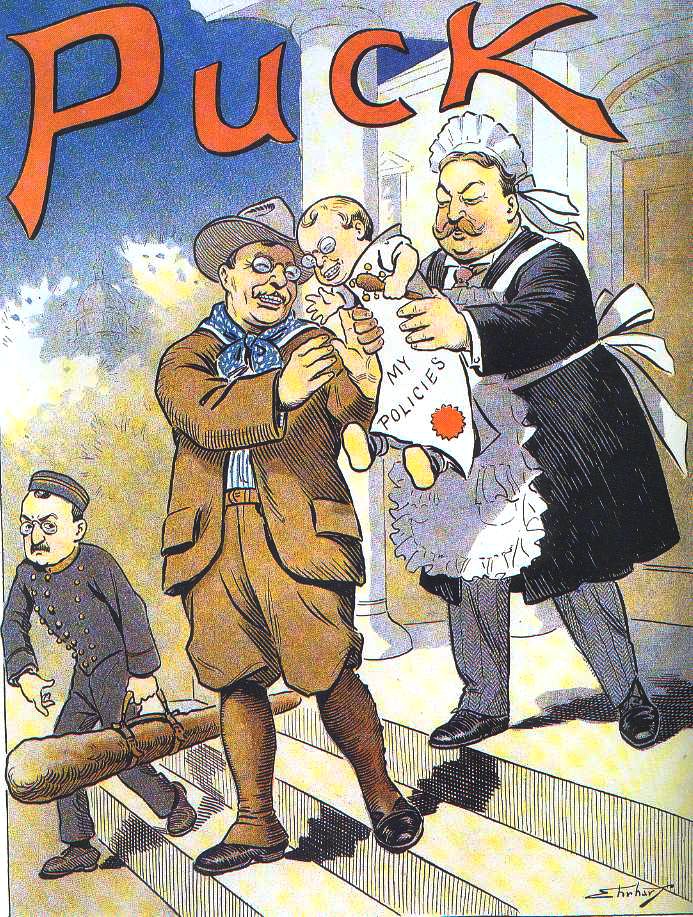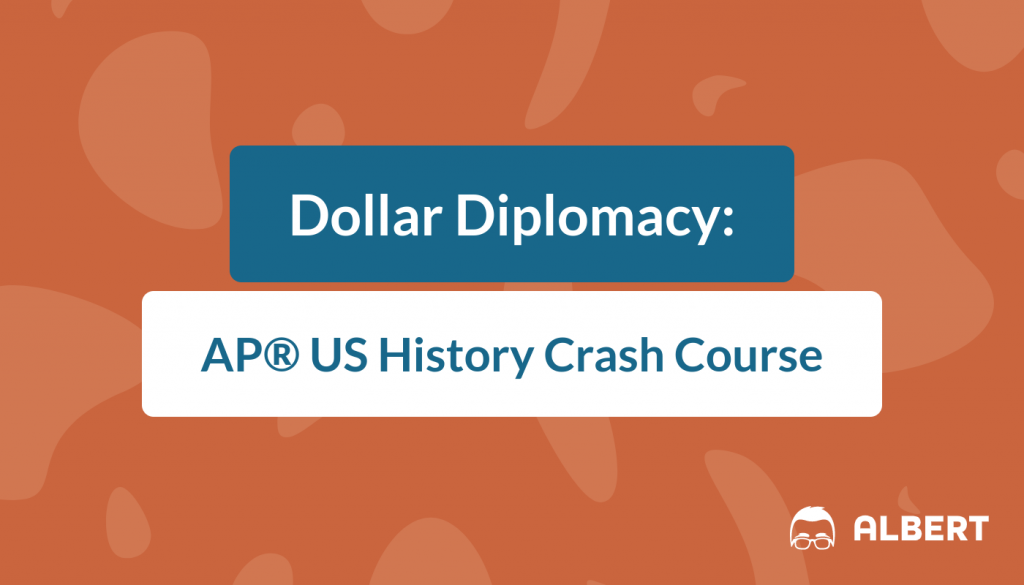Dollar diplomacy–aside from sounding like the name of a movie showing down the street, do you have any idea what it means? Could you explain it to a friend in easy-to-understand terms? More importantly, could you successfully answer an essay question about it on the AP® US History exam? Do you know the politicians involved or at least the associated time period and presidency? Chances are you answered no to at least one of those questions. Thankfully, we’re here to give you a crash course on dollar diplomacy and to explain everything you need to know to ace this topic on the APUSH exam.
Definition
In APUSH, we learn dollar diplomacy is exerting financial power as a form of imperialism. This occurred in the United States during William Howard Taft’s presidency between 1909 and 1913. Taft’s opponents in the U.S. Senate coined the term to describe his use of financial resources to exert control over foreign markets and governments. Taft’s policies relied on the financial strength of the U.S. and particularly impacted countries with a significantly lower economic status. Taft was interested in expanding U.S. influence in many countries, particularly China and Latin America.
Background
Before Taft’s presidency, America experienced the executive authority of Theodore Roosevelt and his “Big Stick” diplomacy attitude about foreign affairs. The desire for imperialism and expansion of American influence dominated policy during this period. Under Roosevelt, the U.S. exerted its power financially and militaristically. He wanted to expand U.S. influence in the global community, and if he had to use military force to do so, he would.
At the beginning of the 20th century, America emerged as an economic powerhouse. The effects of the industrial revolution continued through this era, and industry became increasingly important in the U.S. economy. As the United States increased its participation in international markets, the country started to gain a lot of global influence. With a powerful military to back its thriving economy, the United States became a force to be reckoned with internationally.
Overview
William Howard Taft served as the secretary of war under President Roosevelt from 1904-1908. Taft was a highly influential and well-respected Republican leader of that time, and many considered him Roosevelt’s right-hand man. Thus, it seemed only natural that Taft would successfully run for the office of president in 1908, after Roosevelt’s very successful presidency. However, his agenda proved to be quite different from Teddy’s.

Many of Taft’s biggest changes occurred on an international scale, impacting global relationships. One of Taft’s biggest priorities, with the support of U.S. Secretary of State Philander C. Knox, was to expand the United States economic market. Knox was a businessman and had been immensely successful in the steel industry. His interest in finance certainly guided diplomatic policy at this time. Appropriately known as dollar diplomacy, these policies were, in essence, an attempt to increase the value of the American dollar, both in the U.S. and globally.
Taft built on Roosevelt’s idea of “speak softly and carry a big stick,” except he replaced the use of military force with the use of economic or financial force. He hoped that establishing the prominence of American business would limit power of other countries. Taft primarily focused his efforts to imperialize through economic force on China and various countries in Latin America. With these goals in mind, Taft and his administration became involved in the economic affairs of countries in which America did not have any particular claim.
China had an existing “open door policy” that President Taft hoped to utilize. According to this policy, China was open to free trade so that no one nation could gain too much economic control over the Asian country. However, Taft felt that Japan and Russia had an unfair hold on Chinese business and revenue. Because of this, he worked to get America more involved in China by partnering with Britain, France, and Germany to invest in a massive Chinese railroad project. For numerous reasons, including Japan and Russia’s competitive interest in Chinese business, the railroad project ultimately failed.
Aside from his work in Asia, President Taft was also active at increasing American influence in Latin American countries and parts of Africa. Taft and his counterparts arranged for large investments to be made in countries like Haiti, Liberia, and the Dominican Republic. U.S. leadership felt that giving out loans and investing heavily in each of these countries could bring about some kind of reform or improve U.S. relations. Unfortunately, this was not the case, and many of Taft’s investments backfired. A lot of countries became frustrated with the U.S.’s ambitious involvement where it did not belong, and, in general, dollar diplomacy led to more tension rather than peace.
The United States intended its financial investments not only to improve political and diplomatic relations but also to support U.S. economic interests in these regions. The goal of Taft and Knox’s policies was, in the context of a thriving American economy and ongoing imperialism, a pragmatic one. Increasing the funds available in these countries and their reliance on the United States could have, in theory, increased the reach of the United States both economically and politically.
Many of the countries in Latin America associated with Taft’s economic investment policies had already been experiencing significant political instability. Added financial investments from the United States failed to stabilize these countries, and many experienced significant rebellion and revolution in the years to follow. In some cases, this political instability continued well into the 20th century.
Taft’s successor, President Woodrow Wilson, largely reversed the imperialist policies of his predecessors. Wilson favored moral diplomacy and isolationist policies and sought to preserve the economic and political well-being of the United States within its borders. The isolationism favored by Wilson in response to both big stick and dollar diplomacy slowed the U.S. entry into World War I.
This marks a distinct change from the expansionist polices supported throughout the 19th century.
Why Dollar Diplomacy Matters in AP® US History
Although Taft’s dollar diplomacy generally failed, it is still critical to know about this era as an AP® US History student. First, the loans and economic investments involved in Taft’s particular form of diplomacy eventually led to revolts and civil wars in those countries and, over time, to U.S. military involvement. Its effects, although negative, were indeed far reaching. In addition, changing federal policies about global interaction had a lasting impact on the United States as a part of the world community. The response to dollar diplomacy in the United States was isolationism, leading the U.S. to limit contact with other countries.
Beyond that, the history of dollar diplomacy in America is part of a larger debate that you, as an APUSH student, should understand and even participate in today. This discussion centers on determining the role of America in global affairs–be they political, economic, or military. Discussing these issues requires that you understand the growing tension between imperialists, who seek out more American involvement overseas, and anti-imperialists, who actively avoid that involvement overseas. This debate was a crucial issue during the early 20th century, and the impact of dollar diplomacy continues to this day. The AP® US History exam has asked essay questions about the years leading up to dollar diplomacy, and high-scoring essays consistently expect you to recognize context, including the impact of different historical events. For instance, to score well on this 2007 CollegeBoard question about the impact of Teddy Roosevelt’s policies, you should understand how those policies led to dollar diplomacy. Also, keep in mind that the actions of the United States in the early part of the 20th century also impacted interactions between nations during World War I. You may recognize, in particular, how China and Latin America, chose to engage with the U.S. during the war.
While you’re reviewing for the AP® US History test, you need to know more than just the definition of dollar diplomacy. As highlighted in this article, your APUSH review should also include which president and administration supported the idea, how it manifested itself in American foreign affairs over time, and what its overall lasting effects were, both in the United States and in the relationship of the United States with other countries. Foreign policy is a key defining trait of a presidency, both in the past and today. Make sure to remember that dollar diplomacy is one example of a larger theme in AP® US History, and you have to know its role in that context. Have fun studying!
Looking for AP® US History practice?
Check out our other articles on AP® US History.
You can also find thousands of practice questions on Albert.io. Albert.io lets you customize your learning experience to target practice where you need the most help. We’ll give you challenging practice questions to help you achieve mastery of AP® US History.
Start practicing here.
Are you a teacher or administrator interested in boosting AP® US History student outcomes?
Learn more about our school licenses here.








